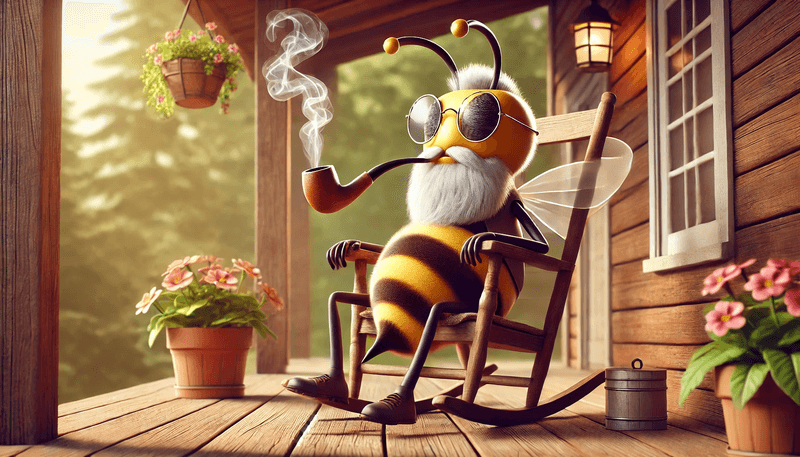
The Surprising Lifespan of Wasps Revealed! Is It Longer Than You Think?
Have you ever wondered how long wasps live? You might be surprised to learn that their lifespan depends on various factors, from food availability to environmental conditions. If you think that wasps simply disappear at the end of the summer, there's much more to their story than meets the eye. In this article, we'll dive into the key elements that influence the lifespan of wasps and explain the seasonal life cycle that governs their survival.
Factors That Influence a Wasp's Lifespan
The lifespan of a wasp can be surprisingly complex and is affected by several critical factors:
- Food Availability: Wasps rely heavily on a variety of food sources, particularly sugary foods like nectar. Adult wasps get most of their food from a sugary liquid, which the wasp larvae regurgitate and feed to the adults. This sugary liquid is made from chitin, a high-quality sugary substance from which insect shells are made. Adult wasps catch insects, they feed these insects to their larvae and in turn the larvae feed part of this food back to the wasps. Adult wasps cannot eat solid food, only liquid. If food is plentiful, the workers within a nest will thrive. However, as summer draws to a close and food becomes scarce, their chances of survival drop dramatically.
- Predators: Wasps face threats from a wide range of predators. Birds, spiders, hornets, and other predatory insects frequently target individual wasps. In some cases, larger predators can attack and destroy entire nests, like badgers, which dig out nests for larvae.
- Temperature: Wasps are highly dependent on warm weather. As temperatures fall with the approach of autumn, it becomes harder for them to find food and maintain the energy they need to survive. By the end of September, no more larvae will be in the nest, so adult wasps will need to search for sugary liquid food. Cooler temperatures can also slow down their metabolism, reducing their lifespan significantly.
A Summer of Activity: The Typical Wasp Lifecycle
Generally, most wasps you encounter throughout the year are workers who only live for a few months during the summer. These worker wasps emerge in the spring and spend their time collecting food to support the nest. With abundant insects, nectar, and sugary substances, wasps remain active and can live throughout the summer months.
Not all wasps will make it through the entire season. Predators are always on the lookout for an easy meal, and individual wasps are constantly at risk of being captured. Birds such as swallows and sparrows are common predators, along with insects like hornets and dragonflies. Even spiders may trap unsuspecting wasps in their webs.
The Autumn Decline: Death of the Nest
As autumn approaches, the food supply for wasps begins to dwindle. Insects become scarce, and the once-abundant nectar dries up. Without a reliable food source, the wasps within the nest slowly starve and die off. By this point, the original queen wasp that founded the colony in the spring is also nearing the end of her life.
In late autumn, when the cold sets in, most of the wasps, including the queen, will have died. The nest itself, which may have housed hundreds or even thousands of wasps during the summer, is now abandoned. It's important to note that a wasp nest is never reused—once it is vacated, the structure begins to deteriorate.
Winter Survivors: The Future Queens
Although most wasps will die as winter arrives, there is one notable exception: newly emerged queen wasps. These future queens are the next generation of colony founders. As autumn ends, they enter a state of hibernation, hiding in sheltered places like tree bark, attic spaces, or even underground crevices.
These queens will remain dormant throughout the cold months, conserving their energy until spring returns. Once temperatures rise again, the queens awaken and search for a new location to start their nests. The new colony will be well underway by late spring, and the cycle will begin anew.
Exceptions and Anomalies
While the general lifespan of wasps follows this seasonal pattern, there are exceptions. In some areas with warmer climates or year-round food availability, wasp colonies may survive longer than usual, sometimes persisting through mild winters. Similarly, some species of wasps, such as paper wasps or yellowjackets, may show different lifecycle patterns compared to the common social wasps.
It's also worth mentioning that solitary wasps, which do not live in colonies, may have shorter or longer lifespans depending on their specific behaviours and environment. These solitary species often live longer as adults, but their life cycle does not involve the large, complex nests that are common among social wasps.
Final Thoughts: Wasps and Their Place in the Ecosystem
The lifespan of a wasp may be shorter than we might think, but their role in the ecosystem is significant. Wasps are natural pest controllers, feeding on other insects that might otherwise damage crops or spread disease. Additionally, they contribute to pollination (in the spring) when they feed on nectar, similar to bees.
Understanding how long wasps live and the factors influencing their survival helps us better appreciate these often misunderstood insects. While most wasps will only survive for a few short months during the summer, the queen wasps that hibernate through the winter ensure the continuation of the species for the following year.
So, the next time you encounter a wasp buzzing around in the summer heat, remember that its time is short. Still, its impact on the environment is lasting. From the diligent workers to the resilient queens, the life cycle of a wasp is a fascinating glimpse into nature's ability to adapt and endure.
